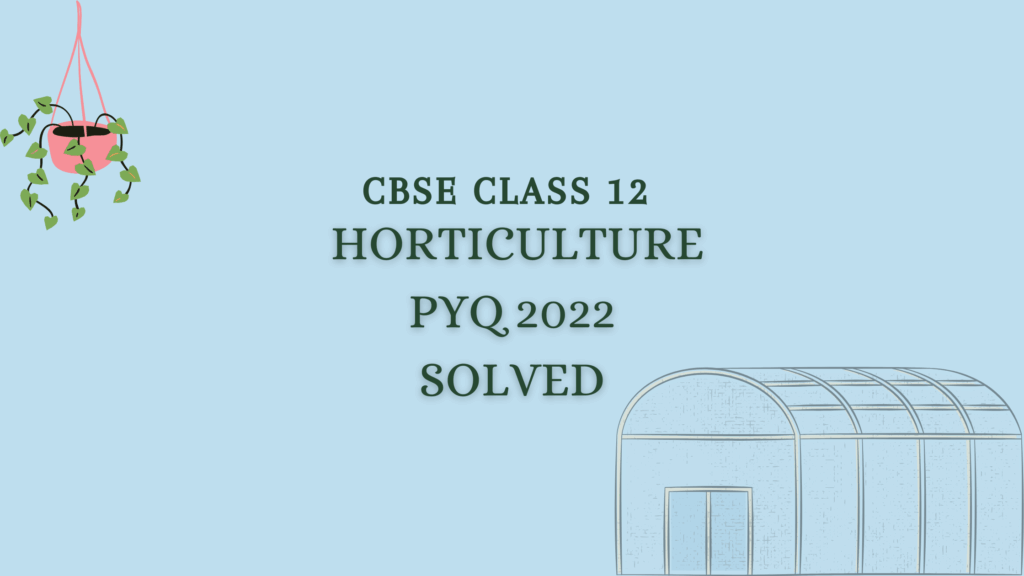CBSE Class 12 Horticulture PYQ 2022 Solved
SECTION A
(Employability Skills)
Answer any 3 questions out of the given 4 questions of 1 mark each. 3×1=3
1. Which one of the following is not a market entry-related difficulty for an entrepreneur? 1
- (a) Taxation
- (b) Lending
- (c) Licensing
- (d) Fear of failure
2. _________ refers to establishing short or long-term objectives, usually along with incorporating deadlines and quantifiable measures. 1
- (a) Team-building
- (b) Goal-setting
- (c) Decision-making
- (d) Risk-taking
3. _________ is a process of continually improving ideas and solutions by making gradual alterations and refinements. 1
- (a) Stress management
- (b) Organizational skills
- (c) Negotiation skills
- (d) Creativity
4. Who ensures that environmentally friendly things are used to build houses and buildings? 1
- (a) Civil Engineer
- (b) Green Builder
- (c) Green Design Professional
- (d) Nature Scientist
Answer any 1 question out of the given 2 questions. 1×2=2
5. List any two green jobs related to solar energy. 2
Ans:
- Electricians who install solar panels
- Plumbers who install solar water heaters
- Construction workers who build energy-efficient green buildings
- Technicians and workers involved in establishing wind power farms
- Those working for clean and renewable energy development.
6. Write a short note on team building. 2
Ans: By finding suitable people and training them to put in their best for the business. One must find people who think and feel like the rest of the team. When new people fit into the culture of the team, work can happen better and faster.
SECTION B
(Subject Specific Skills)
Answer any 5 questions out of the given 7 questions. 5×1=5
7. Which software is regarded as the first CAD software? 1
Ans: Sketchpad
8. What is the pH range for soilless media? 1
- (a) 5·5 to 6·0
- (b) 6·0 to 7·0
- (c) 7·0 to 8·0
- (d) 5·0 to 5·5
9. Aloe barbadensis is a __________. 1
- (a) Low light plant
- (b) Medium light plant
- (c) High light plant
- (d) Ultraviolet light plant
10. Most of the indoor plants grow best at a day temperature ranging from _________ C. 1
- (a) 18 to 24
- (b) 7 to 13
- (c) 13 to 18
- (d) 24 to 27
11. ArchiCAD was first developed by _________. 1
Ans: Graphisoft
12. The most common weed in Indian lawns is _________. 1
- (a) Cyperus rotundus
- (b) Agrostis palustris
- (c) Poa pratensis
- (d) Cynodon dactylon
13. Which is the most destructive pest capable of causing massive damage to turf grounds? 1
Ans: White grubs are the most destructive pest capable of causing massive damage to turf grounds.
Answer any 3 questions out of the given 5 questions. 3×2=6
14. Write a short note on light shade plants with an example. 2
Ans: Light-shade plants are those that thrive in areas receiving filtered sunlight or indirect light, such as under trees or near shaded walls. These plants do not require full sun and can tolerate lower light conditions. Example: Ferns and Hydrangea.
15. What is the meaning of moribana? Why is it called as natural ikebana ? 2
Ans: Moribana is a style of Japanese flower arrangement (Ikebana) where flowers are arranged in shallow containers with a wide mouth using a pin holder (kenzan). It is called natural Ikebana because it uses fresh flowers and foliage arranged in a natural and free-flowing style, resembling landscapes or natural scenes.
16. What is the use of Tissue culture in Cormel production ? 2
Ans: Tissue culture helps in the rapid multiplication of disease-free and uniform cormels (small corms) under controlled conditions. It ensures the availability of high-quality planting material on a large scale, especially for crops like Gladiolus.
17. How is water drying done, and which types of flowers are suitable for such drying? 2
Ans: In water drying, freshly cut flowers are placed in a vase with a small amount of water and allowed to dry naturally as the water evaporates. This method is simple and retains the shape and color of flowers to some extent. Suitable flowers include Hydrangea, Statice, and Baby’s Breath (Gypsophila).
18. What is pinching? How are the different types of pinching done in carnations ? 2
Ans: Pinching is removing the growing tip of a plant to encourage lateral shoot development and bushier growth.
In carnations, two types of pinching are practiced:
- Single pinching: Done 3–4 weeks after planting to promote side shoots.
- Double pinching (Disbudding): Done after the first pinch to allow only one flower per stem by removing side buds, improving flower quality.
Answer any 2 questions out of the given 4 questions. 2×3=6
19. What is Cormel dormancy in terms of plant physiology? How is it broken? 3
Ans: Cormel dormancy refers to a period during which the cormels (small corms) of plants do not sprout or grow even under favorable conditions. This physiological dormancy is due to internal hormonal imbalances, mainly the presence of growth-inhibiting substances.
It can be broken by:
- Treating cormels with gibberellic acid (GA₃)
- Pre-soaking in warm water (40–45°C) for a few hours
- Cold storage for a specific duration to mimic natural winter conditions
20. Write the precautions related to pulsing of gerbera. 3
Ans: Precautions related to pulsing of Gerbera:
- Use clean and sanitized containers and water to avoid microbial growth.
- Maintain optimum sugar concentration (4–6%) and include biocides to prevent stem blockage.
- Keep the flowers upright in a pulsing solution to prevent stem bending.
- Avoid overexposure in pulsing solution to prevent early senescence.
- Maintain cool room temperature (18–20°C) during pulsing.
21. How are budding heights of roses classified? Give an example. 3
Ans: The Budding heights of roses are classified based on the height of the bud union from the ground level:
- Low budding: 15–20 cm (e.g., Floribunda roses)
- Medium budding: 30–45 cm (e.g., Hybrid tea roses)
- High budding: Above 60 cm (e.g., Standard or tree roses)
22. Describe any two diseases of lawn and their control. 3
Ans: Two diseases of lawn and their control:
- Brown Patch (caused by Rhizoctonia solani):
- Symptoms: Circular brown patches, rotting of roots and crowns.
Control: Improve drainage, avoid overwatering, apply fungicides like Mancozeb.
Dollar Spot (caused by Sclerotinia homoeocarpa):
Symptoms: Small, silver-dollar-sized spots, blighted leaf blades.
Control: Proper fertilization, regular mowing, and application of fungicides such as Carbendazim or Thiophanate-methyl.
SECTION C
(Competency-Based Questions)
Answer any 2 questions out of the given 3 questions. 2×4=8
23. How are orchids classified based on habitat and growing pattern? 4
Ans: Classification of orchids based on habitat and growing pattern:
- Based on habitat:
- Epiphytic Orchids: Grow on trees but are not parasitic (e.g., Dendrobium, Cattleya).
- Terrestrial Orchids: Grow in soil (e.g., Spathoglottis).
- Lithophytic Orchids: Grow on rocks (e.g., Paphiopedilum).
- Based on the growing pattern:
- Monopodial Orchids: Have a single, upright stem that grows vertically with leaves arranged alternately (e.g., Vanda).
- Sympodial Orchids: Have a horizontal growth pattern with multiple stems or pseudobulbs (e.g., Oncidium, Dendrobium).
24. Explain chrysanthemum protected cultivation under the following heads: 4
- (a) Environmental factors for growth and flowering
- (b) Propagation
- (c) Nutrition
- (d) Harvesting
Ans: Chrysanthemum protected cultivation:
(a) Environmental factors for growth and flowering:
- Requires a temperature between 15–25°C.
- Needs short-day conditions for flower initiation (less than 13.5 hours of light).
- Humidity should be around 70–80%.
- Good ventilation is necessary in the polyhouse.
(b) Propagation:
- Mostly propagated by terminal stem cuttings.
- Cuttings are rooted in mist chambers before transplanting.
(c) Nutrition:
- Requires balanced NPK (Nitrogen, Phosphorus, Potassium) fertilizers.
- Micronutrients like Mg, Fe, Zn are also important for healthy flowering.
(d) Harvesting:
- Flowers are harvested when the outer florets are fully open.
- Harvesting is usually done in the morning or evening to avoid heat stress.
25. What is Ikebana ? Explain any four types. 4
Ans: Ikebana is the Japanese art of flower arrangement focusing on balance, harmony, and simplicity. It emphasizes natural beauty, line, and space in floral design.
Types of Ikebana:
- Moribana: Uses shallow containers; flowers are arranged in low, broad containers with kenzan (needle holders).
- Nageire: A thrown-in style; uses tall vases and gives a natural, spontaneous look.
- Jiyubana: A freestyle arrangement allowing creativity, using flowers, branches, and even non-plant materials.
- Rikka: A classical and formal style with elaborate arrangements, symbolizing nature’s beauty.
- Shoka: A simplified version of Rikka, with fewer elements focusing on line and form.
CBSE Class 12 Horticulture PYQ 2022 Solved PDF
Click here to download the CBSE Class 12 Horticulture PYQ 2022 Solved PDF.
Additional Study Materials
- Class 12 Horticulture Syllabus 2025-26
- CBSE Class 12 Horticulture 2024 Solved Paper
- CBSE Class 12 Horticulture Paper 2023 Solved




